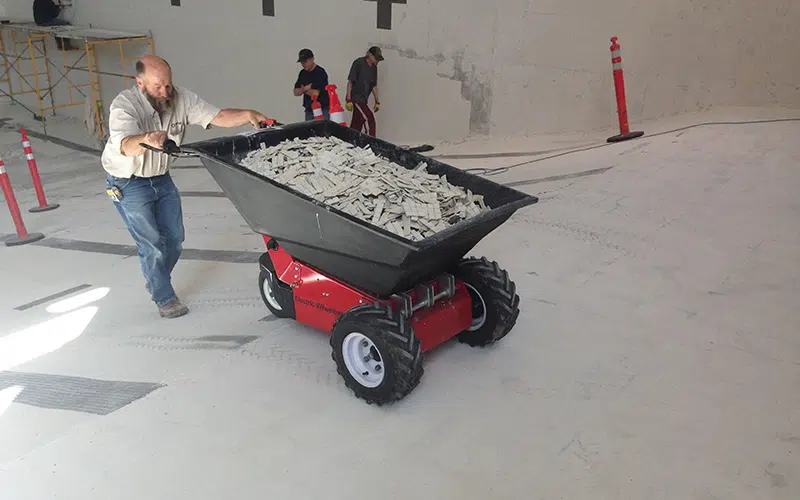Table of Contents
- A Revolution in Manual Labor
- Increased Efficiency and Productivity
- Reducing Physical Strain and Injuries
- Versatility in Use
- Environmentally Friendly Options
- Cost-Benefit Analysis
- User-Friendly Design
- A Future-focus on Innovation
A Revolution in Manual Labor
The evolution of the motorized wheelbarrow represents a paradigm shift in how we approach manual labor. Traditionally reliant on the sheer physical strength of laborers, tasks such as moving construction materials or garden soil demanded significant effort and time. The invention of motorized wheelbarrows has turned these tasks on their head, transforming them into efficient, manageable processes. This innovation is now at the forefront of enhancing productivity in professional construction sites and residential gardening. By harnessing motor power, the strain and time associated with moving heavy loads have been drastically reduced, opening up new possibilities for efficiency across various sectors.

Increased Efficiency and Productivity
The adage “time is money” holds particularly true in construction and gardening. By utilizing motorized wheelbarrows, operations that traditionally consumed hours can now be completed in a fraction of the time. Increasing efficiency and productivity is not merely about moving faster; it’s about doing more with less. This efficiency translates into lower operational costs and heightened project turnover rates. Projects are completed more swiftly, allocating resources to other tasks and ensuring deadlines are met ahead of schedule. The net effect is a significant increase in potential profits and a robust competitive edge in business operations, illustrating a direct correlation between the adoption of motorized technology and fiscal health. Supporting this trend, a recent Business Wire report highlights how improvements in durability and performance of electric wheelbarrows are key drivers of market growth through 2030, reinforcing their value as a smart investment in modern work environments.
Reducing Physical Strain and Injuries
Construction sites and gardens can be physically demanding environments. The traditional use of wheelbarrows requires considerable physical effort, leading to fatigue and a higher risk of injuries due to repetitive strain. Introducing motorized wheelbarrows radically changes this dynamic. These tools can carry heavier loads with less physical input, reducing worker fatigue and the possibility of fatigue-related errors or accidents. As physical strain decreases, so does the probability of sustaining musculoskeletal injuries, common in jobs requiring heavy lifting. This innovation enhances productivity and contributes to a healthier workforce, reducing absenteeism and associated healthcare costs.
Versatility in Use
One of the most commendable attributes of motorized wheelbarrows is their versatility. Unlike their manual counterparts, these machines are not confined to flat, even surfaces. They can handle various terrains, including rugged, muddy, or inclined landscapes, without compromising safety or efficiency. This adaptability makes them invaluable in diverse environments—hilly construction sites, expansive agricultural fields, or compact urban gardens. As highlighted in this article by 99% Lifestyle, their ability to perform reliably across such varied conditions is one of the key reasons they’re increasingly favored for professional and personal use. Their versatile nature means they can be used in numerous applications, providing consistent service across different projects and terrains, thus proving an indispensable asset in various demanding conditions.
Environmentally Friendly Options
The drive towards sustainable and eco-friendly construction practices has led to the development of motorized wheelbarrows fitted with electric motors. These models operate with significantly reduced emissions compared to traditional gas-powered wheelbarrows, contributing to a cleaner environment. As industries seek to reduce their carbon footprints, introducing electric motorized wheelbarrows paves the way for greener construction initiatives. By declining reliance on fossil fuels, these eco-friendly options support global sustainability goals and present a future where technological innovation and environmental responsibility go hand in hand.
Cost-Benefit Analysis
The initial financial outlay for acquiring a motorized wheelbarrow may appear substantial, but a detailed cost-benefit analysis swiftly highlights its value. Operational costs can be significantly reduced by lessening the need for manual labor. Additionally, enhanced safety and efficiency contribute to fewer accidents and project delays. Over time, these benefits typically outweigh the upfront purchase costs, leading to faster recoupment of investment and increased operational profitability. This balance of cost versus benefit illustrates why many businesses view motorized wheelbarrows not just as a tool, but as a strategic investment in the efficiency and safety of their operations.
User-Friendly Design
The design philosophy behind motorized wheelbarrows emphasizes user experience. Features like ergonomic handles, intuitive controls, and balance-focused designs ensure easy operation, even for those less experienced with machinery. These design elements significantly reduce the learning curve, promoting quicker proficiency and fewer operation mistakes. In essence, motorized wheelbarrows are designed to empower users, making them accessible to a broad audience, including amateur gardeners and seasoned construction workers looking to streamline their tasks easily and efficiently.
A Future-focus on Innovation
As technology continues to advance, the future of motorized wheelbarrows looks promising. Anticipated innovations include enhancements such as integrated navigation systems, further reductions in energy consumption, and increased load capacities. These improvements will likely enhance their autonomy and efficiency, making them even more integral to construction and gardening practices. With continued research and development, motorized wheelbarrows will likely evolve, maintaining their trajectory of innovation and cementing their place as essential tools for modern efficiency in manual labor tasks.



